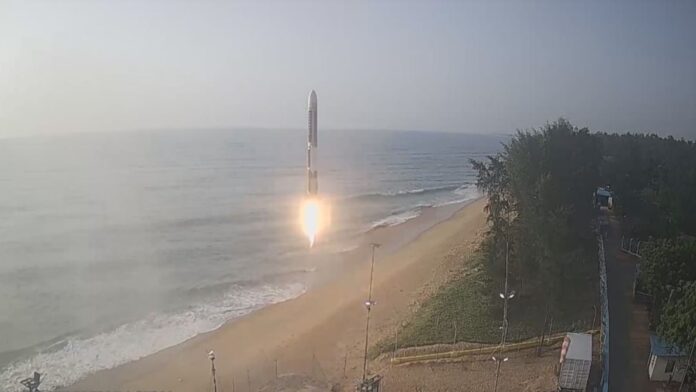The ISRO praised Agnikul, calling it “a major milestone, as the first-ever controlled flight of a semi-cryogenic liquid engine realised through additive manufacturing”.
Agnikul Cosmos, an Indian space startup, successfully launched its first sub-orbital test vehicle on Thursday, propelled by the world’s first single-piece 3D-printed rocket engine, after cancelling at least four prior launches.
Agnibaan SOrTeD (Sub-Orbital Technology Demonstrator) launched at 7.15 a.m. on Thursday, marking a number of firsts. While this is the second launch by a private startup in India, it is the first to use a private launchpad established by the business at Sriharikota, the country’s only functioning spaceport.
“Congratulations on the successful launch of Agnibaan SOrTeD by @AgnikulCosmos! A watershed event for India’s space sector. This breakthrough, powered by the world’s first single-piece 3D printed semi-cryogenic engine, demonstrates the ingenuity of our young innovators,” said Dr Pawan Goenka, chairman of IN-SPACe, which is in charge of coordinating with the private space sector, on X.
In a post on X, the Indian Space Research Organisation (ISRO) also hailed Agnikul, stating it is “a major milestone, as the first-ever controlled flight of a semi-cryogenic liquid engine realised through additive manufacturing”.
Typically, engine parts are manufactured separately and assembled later. Using the 3D-printed manufacturing process is likely to lower the launch cost and cut down the vehicle assembly time. The company aims to offer affordable launch services to small satellites.
“We are proud to present India’s first semi-cryo rocket engine, which is also the world’s most integrated single shot 3D printed piece. It signals the ability to rapidly assemble rockets that is unparalleled,” said Prof Satyanarayanan R Chakravarthy, founding advisor Agnikul Cosmos and head of National Centre for Combustion Research and Development, IIT Madras.
The launch vehicle, developed by the IIT Madras-incubated startup, also demonstrated India’s first semi-cryogenic engine. The engine—called Agnilet—uses sub-cooled oxygen as fuel. Cryogenic engines, such as the one used in the upper stages of India’s heaviest launch vehicle, LVM3, use gases liquified at extremely low temperatures as fuel.
The launch vehicle has been designed to launch from its mobile launchpad, called Dhanush, from any location. While this was a suborbital launch, the vehicle can fly payloads ranging from 30 kg to 300 kg.
The mission was designed to reach a height of about 8 kilometres before splashing into the sea. The company hopes to conduct its first orbital launch, which will be able to carry satellites to an orbit around the Earth by the end of the financial. They hope to provide regular launched in the next calendar year. The other private launch provider Skyroot, which achieved its first sub-orbital launch in 2022, is also likely to undertake its first orbital launch this year.
“This is the culmination of 1000s of hours of reviews and hard work by the team. We are blessed to have had the opportunity and the full support of IN-SPACe and ISRO to design and build original space worthy hardware in India,” said Srinath Ravichandran, co-founder and CEO of Agnikul Cosmos.
Stay Connected With us: Siasatpro.com



Recent Comments